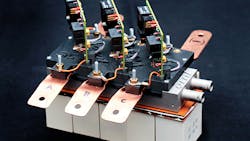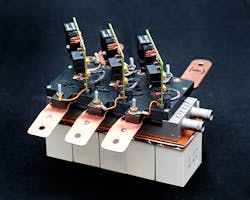3D Printed Inverter Could Kickstart Electric Cars
Engineers at Oak Ridge National Laboratory have combined 3D printing and a wide-bandgap version of silicon carbide to come up with a lightweight, compact 30-kW traction-drive inverter. It converts dc to ac power with nearly 99% efficiency. The liquid-cooled inverter prototype could lead to lighter, more powerful battery-powered vehicles.
Half of the inverter’s parts were made using 3D printing, a construction technique that allows experimentation with a variety of complex shapes for components. For example, by quickly producing and testing several different heat sinks, the team was able to improve heat transfer throughout the device. It also let them place lower-temperature components close to higher-temperature ones to reduce electrical losses and shrink the overall size of the inverter.
The wide-bandgap silicon makes the inverter more efficient at wider range of temperatures than conventional semiconductor materials. The material also lets the inverter be more reliable, lighter, more compact, and have a high power density.
Another key to the project’s success was using several relatively small, lower-cost capacitors hooked up in parallels to reduce heating compared to the conventional approach of using fewer, larger, and more expensive “brick-type” capacitors.
The team is working on a second iteration of the inverter, one that will use even a higher percentage of 3D printed parts and have roughly four times the power density of the current prototype.

